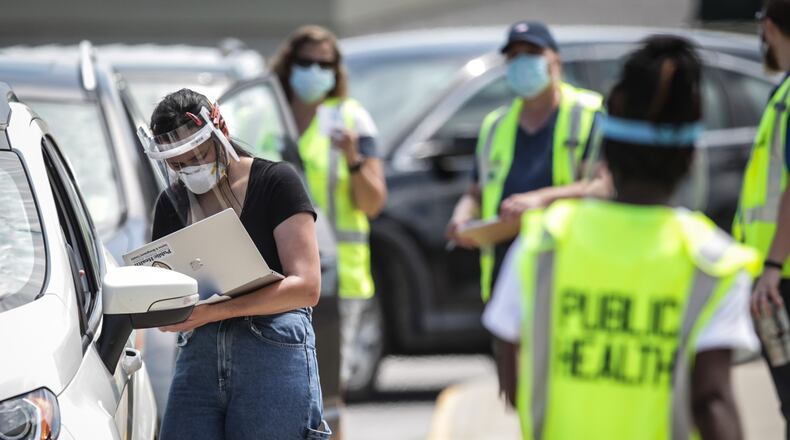The Ohio Public Health Advisory Alert System has four levels of alerts, based on how many of seven different indicators of coronavirus spread that each count meets. A level four alert is the highest alert level and means that people in that county are advised to only go out in public for essentials.
“The good news is that more people are wearing masks in our urban counties and we are seeing the spread slow,” DeWine said. “The bad news is our more rural counties are turning orange (level 2) with significantly more spread taking place.”
Montgomery County remains at a level three alert, based on its concerning levels of new cases per capita, new cases increasing, it’s high-level of cases outside of congregated settings like nursing homes, and it’s rising emergency and outpatient visits for COVID-19. People in counties considered level three are advised to decrease in-person interactions with others, consider necessary travel only, and limit attending gatherings of any number.
Shelby, Darke, Miami, Preble, Greene, Butler and Warren counties were at level two. Champaign County is the only county at level one in the Miami Valley region.
“This virus is vicious,” DeWine said, noting that it doesn’t matter if you’re with family or friends and that anyone can catch it.
There will be a free pop-up testing site from 9 a.m. to 4 p.m. Aug. 5 at the Wright State University Nutter Center, at 3650 Colonel Glenn Highway in Fairborn. Greene County Public Health said the average turn around time for lab results is between two to seven days.
Public Health - Dayton & Montgomery County will also have pop-up testing Aug. 3 from noon to 6 p.m. at the Montgomery County Fairgrounds at 645 Infirmary Road in Jefferson Twp.
Public Health - Dayton & Montgomery County held a series of pop-up testing sites around the county in recent weeks and Thursday announced there were 209 positive cases combined from the three pop-up testing sites. There were 1,058 people tested at the Rose Music Center pop-up, 1,168 tested at Trotwood Madison High School pop-up, and 1,478 tested at the Montgomery County Fairgrounds.
.
Under the new data released Thursday, Montgomery County had 784 new cases during the past 14 days, which is considered “high incidence” by the CDC definition.
Average daily visits for COVID-19 to the emergency department in Montgomery County dipped down from July 14 to July 21 to an average of 9 visits but climbed back up to an average of 16 visits by July 29.
COVID-19 average outpatient visits declined from 79 visits July 14 to 50 visits July 23, though have been ticking up over the last week and sat at 59 visits as of July 28.
From July 10 to July 16, 79% of the cases are not in congregate settings, such as nursing homes, which is a signal of transmission in the broader community, where if most cases are in congregate settings that’s a more contained outbreak that needs less sweeping measures. Preliminary data, which could change as more cases come in, shows 50% of cases were non-congregate cases from July 17-23 and 5% of cases were non-congregate cases for July 24-July 30.
Montgomery County is part of an eight-county region that is coordinating on bed capacity during the public health emergency, and there are about 375 ICU beds in the region. About 71% of ICU beds were reported full as of July 28 and about 12% were full with COVID patients.
Summary of Ohio Public Health Advisory Alert System 7 indicators
When determining whether a county is a level one, two, three or four alert, the system looks at how many of the following seven indicators that counties meet:
New cases per capita: Flagged if greater than 50 cases per 100,000 residents over the last two weeks. Allows for counties with different population sizes to be appropriately compared.
Sustained increase in new COVID-19 hospital admissions: Flagged if increasing trend of at least 5 consecutive days in overall cases by onset date over the last 3 weeks. Reflects disease spread in the population.
High proportion of cases that aren’t congregate cases: Flagged if proportion of cases that are not in a congregate setting goes over 50% in at least one of the last 3 weeks.
Sustained increase in emergency visits for COVID-like illness: Flagged if increasing trend of at least 5 consecutive days in the number of visits to the emergency department with COVID-like illness or a diagnosis over the last 3 weeks.
Sustained increase in outpatient visits: Flagged if increasing trend of at least 5 consecutive days in the number of people going to a health care provider with COVID symptoms who then receive a COVID confirmed or suspected diagnosis over the last 3 weeks.
Sustained increase in new COVID-19 hospital admissions: Flagged if increasing trend of at least 5 consecutive days in the number of new hospitalizations due to COVID over the last 3 weeks.
ICU bed occupancy: Flagged if percentage of the occupied ICU beds in each region goes above 80% for at least three days in the last week, and more than 20% of ICU beds are being used for COVID-19 positive patients for at least three days in the last week.
About the Author
